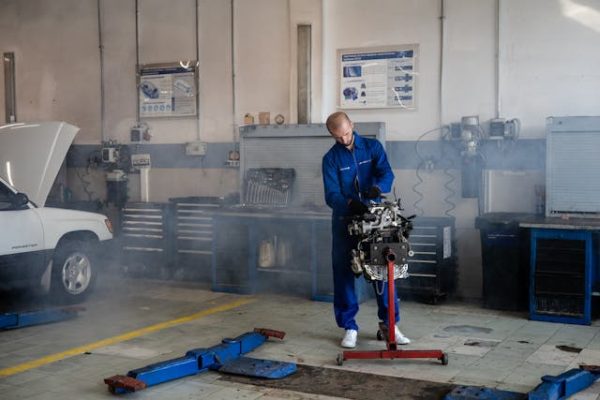Branded Content by Cosmic Press
The average age of automobiles on the roads of the US has been climbing higher over the decades. This is a clear sign of progress being made not only in terms of the durability of vehicle designs and the materials used in their construction, but also the sophistication of the systems beneath the skin which detect and deal with maintenance-related issues.
In fact data from S&P Global Mobility found that 13.1 years was the expected age for a given car encountered on the nation’s roads in 2022. This figure has climbed steeply since 2016, and points to a future in which further increases are likely.
To get to the bottom of why this is happening, here’s an examination of the technologies and techniques that are at play in maintaining and repairing vehicles today.

Image Source: Pexels
AI Diagnostics
Cars have had integrated sensors to detect faults and alert drivers to issues for many years. However, this is a primitive approach compared with what’s possible in the age of artificial intelligence. This is already a $7.74 billion market in the automotive niche alone, and is set to undergo further growth in the coming decade.
Basically, advanced AI systems are being integrated into vehicles to pinpoint issues precisely. These tools use machine learning algorithms to analyze data from various sensors, spotting patterns and anomalies that signal potential problems. This means there’s more nuance in how diagnostics are handled, rather than it being a binary between functional and broken.
Here’s how these tools transform vehicle repairs:
- Quick Issue Identification: Detects faults faster than traditional methods.
- Predictive Analysis: Anticipates future failures based on historical data.
- Guided Repairs: Offers step-by-step fixes, reducing human error.
- Data Integration: Collates info from multiple sources for a comprehensive view.
Tech giants including NVIDIA are getting into the automotive game specifically because AI is now a going concern in this arena. Their input will surely shake up the market even further going forward, so ambitious engineering students would do well to get up to speed with what’s already possible in this arena.
3D Printing
Needing a rare car part and being able to create it on-site and on demand is the reality with 3D printing in automotive repair. And since this is also a technology that engineering students can harness, getting to grips with it is a good idea for those aiming to enter the auto industry once they graduate.
Shops can use industrial-grade printers to create custom parts, drastically reducing wait times. This tech proves particularly invaluable for vintage car enthusiasts, as replacement parts are scarce or out of production altogether in this scene.
One prime example is Stratasys’s Fortus 450mc, which is known for its precision and durability. It prints components with complex geometries that would be tough or impossible to manufacture using traditional methods.
Additional benefits of integrating 3D printing include:
- Rapid Prototyping: Create prototypes quickly to test fit and function before final production.
- Cost Efficiency: Reduces costs by minimizing waste material.
- Customization: Easily modifies designs for specific needs.
- Supply Chain Optimization: Lowers dependency on extensive inventories.
Of course it’s still the case that auto parts will not all be produced by this method. In fact with vendors like Source One on the scene, acquiring hard-to-find components quickly and cost-effectively has never been simpler. It’s just that engineering students stand to benefit from being proficient with 3D printing solutions, and vehicle repair is a worthy example of where this can be applied practically.
Advanced Troubleshooting for Electric Vehicle Systems
EV sales are expected to generate over $82 billion this year alone, but cars in this category come with unique repair challenges. As a result, traditional mechanics often face a steep learning curve when dealing with these high-voltage systems.
One essential tool is Fluke’s 88V Multimeter. It’s designed to handle the high voltages and currents typical in EVs. This is just one type of hardware that automotive specialists will have to upskill to use effectively.
On top of this, here’s why mastering EV troubleshooting matters:
- High-Voltage Safety: Understanding how to safely interact with and discharge high-voltage batteries.
- Specialized Software: Using proprietary diagnostic software to communicate with vehicle control units.
- Component Familiarity: Recognizing parts like inverters, regenerative braking systems, and electric drivetrains.
Future engineers should also stay current (pun intended) on emerging technologies such as solid-state batteries and wireless charging stations, as these advancements will shape next-gen EV repairs. Being proficient in these areas ensures you’ll be at the forefront of this electrifying shift in automotive technology.
Final Thoughts
A combination of different, seemingly distinct tech breakthroughs are coming together to reshape automotive design and define what vehicle repairs will look like in years to come. This means engineering students have to be across everything from AI to 3D printing and EV hardware if they intend to thrive in a career that puts cars at its core.
Branded content furnished by our promotional partners. The Daily Sundial editorial staff is not involved in its production. Content does not reflect the views or opinions of the editorial staff.








